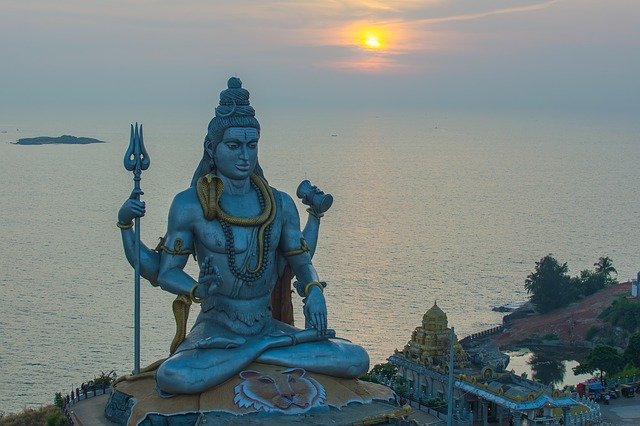
In Hindu mythology the story of Shivaratri or the Night of Shiva is a beautiful and powerful one. It is also, as most Hindu myths are, packed with metaphor and meaning which are useful to us in our daily struggles.
Long ago, the Devas or gods and the Asuras or demons decided to churn the ocean of milk in order to obtain the nectar of immortality, which lay buried deep within its waters. To do this they needed a strong base on which their churning rod could rest and so they prayed to Lord Vishnu for help. He agreed to serve as the base by taking the form of a giant turtle, and resting on the bottom of the ocean. For the rod they used the highest mountain, Mandhara Parvath. Next the Devas and Asuras needed something strong enough and large enough to serve as the churning rope. They approached the giant snake Vasuki, who agreed to help them.
The gods on one side and the demons on the other began churning the rope in unison and slowly the ocean grew white with foam. Suddenly to their dismay, Vasuki, who was being pulled and pushed mercilessly, began spewing his venom into the air. The fumes were so strong and so potent that the Devas and Asuras fell to the ground in a faint. The vapor spread until the sky and the earth were covered and the three worlds began to tremble in fear. It was at this crucial moment that Lord Shiva appeared and taking a giant breath inhaled all the poison into himself. Immediately the sky began to clear and all living creatures revived again. Shiva inhaled the poison but knew that if he swallowed it, he too would be destroyed. Unable to swallow and unable to spew out the venom thereby destroying the universe, Shiva kept it locked within his throat and fell into a dead faint, overwhelmed by the toxic fumes he held within. That entire night, as Shiva lay unconscious the three worlds prayed for his recovery. It is that night which is celebrated as Shivaratri. The whole night through the devas prayed and chanted and sang his glory until finally the next morning he awoke. His throat which held the poison, took on a permanent blue hue, earning him the name of Neelakanta or Blue-throated One.
After jubilant celebrations of Shiva’s recovery the Devas and Asuras resumed the churning of the Ocean. After the fumes dispersed, beautiful rare and incredible riches began emerging from the waters. At last the Amrita or Nectar of Immortality and Bliss emerged and the devas and asuras lined up to receive it. They soon fell to fighting among themselves, greedy to get the largest share until once again Lord Vishnu came to the rescue by taking the form of a celestial nymph Mohini and arousing the demons’ lust and destroying them so that only the devas were allowed to drink the nectar and achieve eternal bliss.
The story of Shivaratri and the churning of the ocean is, like most stories from Hindu myth, about the self and its quest for realization. As Paramahamsa Prajnanananda explains, the giant turtle represents the ability to withdraw the sense organs, for only turtles can withdraw their limbs at approaching danger. The senses too, should be withdrawn from the dangers and distractions of Maya or illusion. The solid mountain churn is the strong and healthy body, which when tied with the rope of the mind turns this way and that toward the devas, who are good propensities and then toward the asuras who are evil propensities. Turning first one way, then another, the mind begins spewing venom, and the churning brings forth the poison which lies at the surface, years of bad habits, thoughts, impulses begin to be churned to the surface and released. Those who practice kriya know that in the initial stages of meditation, just such a cleansing occurs and the release of toxic impulses and desires can often be a painful and disturbing experience. Such impulses and desires need to be controlled and like Shiva, we must swallow them through constant meditation, neither allowing them to be reabsorbed nor releasing them on to others and causing harm. It is only after the surface dirt is cleared, that we begin to find priceless treasures within. Wealth, prosperity, material satisfaction, comfort and luxury, name and fame and many powers may come to us, as faithful practitioners of kriya yoga, but like the devas we should not be distracted but continue with our labor until at last we obtain the nectar of bliss or self-realization. We should be careful at that final moment not to feed the demons of our evil propensities but to strengthen the good and emerge victorious.
This is the inner meaning of Shivarathri and this struggle for self-realization is what we truly celebrate on this auspicious night according to Baba. We celebrate the power of self-control, the ability to swallow the poisons which our mind spews forth and yet remain serene, calm and wise as Shiva does. We rejoice in the victory of our good propensities over our bad, and finally we praise the infinite mercy of God who serves as the base of all our struggles and who is the foundation on which we place our faith and hope for salvation.
mata me parvati devi pita devo maheshwarah
vandhavah siva bhaktasca svadesho bhuvama tryam.
Parvati is my Mother, Shiva, the Father. All the lovers of God are my relatives and the universe is my home.
